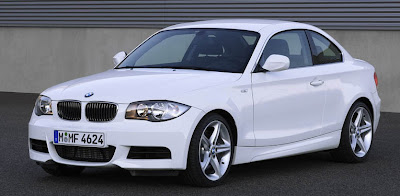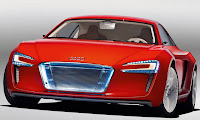BMW 320d EfficientDynamics, 2010
>> Thursday, January 6, 2011
BMW 320d EfficientDynamics, 2010
Teaming up with the BMW 320d, the new BMW 320d EfficientDynamics Edition is being presented for the first time at the 2009 Frankfurt Motor Show. This unique saloon combines fuel consumption of just 4.1 litres diesel/100 kilometres (equal to 68.9 mpg imp) and a CO2 rating of 109 grams per kilometre in the EU test cycle with engine output of 120 kW/163 hp.
The 2.0-litre four-cylinder diesel engine of this high-tech model boasts an all-aluminium crankcase, turbocharging with variable intake geometry and common-rail direct fuel injection complete with piezo-injectors. With the engine and the entire car modified once again for an even higher standard of efficiency, this unique saloon targeted above all at the German, Italian, French and Spanish markets comes with optimised aerodynamics, an extra-long final drive ratio, and an innovative two-mass flywheel incorporating a centrifugal-force pendulum.
All this makes the BMW 320d EfficientDynamics Edition the most fuel-efficient and lowest-emission car in BMW's current model range. In the fiercely contested midrange segment it is an unparalleled, highly attractive premium offer for the truly demanding and progressive customer focusing primarily on superior economy and the environment, without wishing to forego the sporting driving characteristics so typical of a genuine BMW.
The enhanced efficiency already offered by the existing models in the BMW 3-Series thanks to BMW EfficientDynamics making these cars superior to their competitors, is now raised to an even higher level in the BMW 320d EfficientDynamics Edition.
Four-cylinder diesel engine with optimised efficiency and superior performance all in one.
The BMW 320d EfficientDynamics Edition is powered by a four-cylinder diesel engine specifically optimised for even greater fuel economy and emission management and, therefore, for a standard of efficiency never seen before. All this comes from the 2.0-litre four-cylinder power unit with its all-aluminium crankcase, turbocharging and the latest generation of common-rail fuel injection featured with various power stages also in the BMW 316d, the BMW 318d and the BMW 320d. The engine specially conceived for the BMW 320d EfficientDynamics Edition develops maximum output of 120 kW/163 hp at an engine speed of 3,500-4,200 rpm and peak torque of 360 Newton-metres/265 lb-ft all the way from 1,750 to 3,000 rpm.
The engine stands out in particular through its sporting and dynamic power from low revs. The innovative centrifugal-force pendulum incorporated in the two-mass flywheel, together with the longer transmission ratio, serves to significantly reduce the level of engine speed at all road speeds relevant in practice in the BMW 320d EfficientDynamics Edition. The shift in load points beneficial to fuel economy and emissions goes together in this case with full maintenance of the spontaneity and running smoothness so typical of a BMW diesel.
To ensure smooth driving characteristics free of vibration also when driving at particularly low engine speeds, the power unit of the BMW 320d EfficientDynamics Edition features a so-called centrifugal pendulum efficiently compensating any unsmoothness in running characteristics typically encountered at low revs. This innovative component is integrated in the engine's two-mass flywheel where it dampens the vibrations generated under load, thus ensuring comfortable and acoustically optimised development of power and performance all the way from low engine speeds.
This increase in motoring comfort will encourage the driver to use a higher gear more often or, respectively, not to shift back as he otherwise would do. But when accelerating the BMW 320d EfficientDynamics Edition still offers the driving behaviour and agility so typical of BMW.
The driving dynamics characteristic of a BMW are borne out also by the car's acceleration to 100 km/h in just 8.2 seconds and by the BMW 320d EfficientDynamics Edition accelerating in fifth gear from 80-120 km/h in 9.6 seconds. Top speed is 225 km/h or 140 mph.
Lower emissions, more driving pleasure: consistently implementing the potential of BMW EfficientDynamics.
The BMW 320d EfficientDynamics Edition comes with the complete range of technologies serving to reduce both fuel consumption and emissions and already featured as standard on the other models in the BMW 3-Series. Brake Energy Regeneration, for example, serves to concentrate the generation of electric power for the on-board network on overrun and the application of the brakes, thus avoiding even the slightest increase in fuel consumption. The Auto Start Stop function, in turn, switches off the engine even during a short stop in traffic, avoiding any unnecessary consumption of fuel while idling. The gearshift point indicator on the BMW 320d EfficientDynamics Edition, to mention yet a further example, tells the driver in good time when to shift gears in the interest of optimum efficiency. And like the detachable climate compressor, EPS Electronic Power Steering operates only when needed, again in the interest of maximum efficiency.
The electric motor featured within the EPS system therefore takes up energy only when really needed for power assistance or when required by the driver. Active cooling through air flap control and tyres with reduced roll resistance also serve to enhance the car's efficiency, and the BMW 320d EfficientDynamics Edition is likewise fitted with a diesel particulates filter close to the engine. It almost goes without saying, finally, that the BMW 320d EfficientDynamics Edition fulfils the EU5 emission standard in full.
The fuel economy and emission management also featured in the other models in the BMW 3-Series are combined in the BMW 320d EfficientDynamics Edition with additional innovations, which, together with the decrease in engine power on the BMW 320d by 10 kW or 14 hp, serve to reduce fuel consumption and emissions to an even lower level, below the CO2 standard of 110 grams per kilometre relevant to taxation in many countries.
These additional features include a longer final drive ratio and the lower chassis and suspension of the car. Newly developed Aero wheel rims in turbine wheel design - the only optical sign of distinction on the car to be seen from outside - improve the level of aerodynamics to an even higher standard, giving the BMW 320d EfficientDynamics Edition a drag coefficient of just 0.26.
Within the BMW 3-Series the BMW 320d EfficientDynamics Edition is the so far most consistent implementation of the BMW EfficientDynamics development strategy, offering the motorist who really appreciates the premium character and sporting driving qualities of a BMW 3-Series and at the same time attaches utmost significance to superior economy exactly the right choice in the midrange market segment.
Comparing the efficiency of all models in this segment, BMW, introducing the BMW 320d EfficientDynamics Edition, is once again moving a step ahead of the competition. And following BMW's general policy, the improvement of efficiency offered by this innovative technology does not even require the payment of a higher price for the BMW 320d EfficientDynamics Edition, which therefore comes at the same price as the "regular" BMW 320d, which naturally is still included in BMW's model range.
Read more...
The 2.0-litre four-cylinder diesel engine of this high-tech model boasts an all-aluminium crankcase, turbocharging with variable intake geometry and common-rail direct fuel injection complete with piezo-injectors. With the engine and the entire car modified once again for an even higher standard of efficiency, this unique saloon targeted above all at the German, Italian, French and Spanish markets comes with optimised aerodynamics, an extra-long final drive ratio, and an innovative two-mass flywheel incorporating a centrifugal-force pendulum.
All this makes the BMW 320d EfficientDynamics Edition the most fuel-efficient and lowest-emission car in BMW's current model range. In the fiercely contested midrange segment it is an unparalleled, highly attractive premium offer for the truly demanding and progressive customer focusing primarily on superior economy and the environment, without wishing to forego the sporting driving characteristics so typical of a genuine BMW.
The enhanced efficiency already offered by the existing models in the BMW 3-Series thanks to BMW EfficientDynamics making these cars superior to their competitors, is now raised to an even higher level in the BMW 320d EfficientDynamics Edition.
Four-cylinder diesel engine with optimised efficiency and superior performance all in one.
The BMW 320d EfficientDynamics Edition is powered by a four-cylinder diesel engine specifically optimised for even greater fuel economy and emission management and, therefore, for a standard of efficiency never seen before. All this comes from the 2.0-litre four-cylinder power unit with its all-aluminium crankcase, turbocharging and the latest generation of common-rail fuel injection featured with various power stages also in the BMW 316d, the BMW 318d and the BMW 320d. The engine specially conceived for the BMW 320d EfficientDynamics Edition develops maximum output of 120 kW/163 hp at an engine speed of 3,500-4,200 rpm and peak torque of 360 Newton-metres/265 lb-ft all the way from 1,750 to 3,000 rpm.
The engine stands out in particular through its sporting and dynamic power from low revs. The innovative centrifugal-force pendulum incorporated in the two-mass flywheel, together with the longer transmission ratio, serves to significantly reduce the level of engine speed at all road speeds relevant in practice in the BMW 320d EfficientDynamics Edition. The shift in load points beneficial to fuel economy and emissions goes together in this case with full maintenance of the spontaneity and running smoothness so typical of a BMW diesel.
To ensure smooth driving characteristics free of vibration also when driving at particularly low engine speeds, the power unit of the BMW 320d EfficientDynamics Edition features a so-called centrifugal pendulum efficiently compensating any unsmoothness in running characteristics typically encountered at low revs. This innovative component is integrated in the engine's two-mass flywheel where it dampens the vibrations generated under load, thus ensuring comfortable and acoustically optimised development of power and performance all the way from low engine speeds.
This increase in motoring comfort will encourage the driver to use a higher gear more often or, respectively, not to shift back as he otherwise would do. But when accelerating the BMW 320d EfficientDynamics Edition still offers the driving behaviour and agility so typical of BMW.
The driving dynamics characteristic of a BMW are borne out also by the car's acceleration to 100 km/h in just 8.2 seconds and by the BMW 320d EfficientDynamics Edition accelerating in fifth gear from 80-120 km/h in 9.6 seconds. Top speed is 225 km/h or 140 mph.
Lower emissions, more driving pleasure: consistently implementing the potential of BMW EfficientDynamics.
The BMW 320d EfficientDynamics Edition comes with the complete range of technologies serving to reduce both fuel consumption and emissions and already featured as standard on the other models in the BMW 3-Series. Brake Energy Regeneration, for example, serves to concentrate the generation of electric power for the on-board network on overrun and the application of the brakes, thus avoiding even the slightest increase in fuel consumption. The Auto Start Stop function, in turn, switches off the engine even during a short stop in traffic, avoiding any unnecessary consumption of fuel while idling. The gearshift point indicator on the BMW 320d EfficientDynamics Edition, to mention yet a further example, tells the driver in good time when to shift gears in the interest of optimum efficiency. And like the detachable climate compressor, EPS Electronic Power Steering operates only when needed, again in the interest of maximum efficiency.
The electric motor featured within the EPS system therefore takes up energy only when really needed for power assistance or when required by the driver. Active cooling through air flap control and tyres with reduced roll resistance also serve to enhance the car's efficiency, and the BMW 320d EfficientDynamics Edition is likewise fitted with a diesel particulates filter close to the engine. It almost goes without saying, finally, that the BMW 320d EfficientDynamics Edition fulfils the EU5 emission standard in full.
The fuel economy and emission management also featured in the other models in the BMW 3-Series are combined in the BMW 320d EfficientDynamics Edition with additional innovations, which, together with the decrease in engine power on the BMW 320d by 10 kW or 14 hp, serve to reduce fuel consumption and emissions to an even lower level, below the CO2 standard of 110 grams per kilometre relevant to taxation in many countries.
These additional features include a longer final drive ratio and the lower chassis and suspension of the car. Newly developed Aero wheel rims in turbine wheel design - the only optical sign of distinction on the car to be seen from outside - improve the level of aerodynamics to an even higher standard, giving the BMW 320d EfficientDynamics Edition a drag coefficient of just 0.26.
Within the BMW 3-Series the BMW 320d EfficientDynamics Edition is the so far most consistent implementation of the BMW EfficientDynamics development strategy, offering the motorist who really appreciates the premium character and sporting driving qualities of a BMW 3-Series and at the same time attaches utmost significance to superior economy exactly the right choice in the midrange market segment.
Comparing the efficiency of all models in this segment, BMW, introducing the BMW 320d EfficientDynamics Edition, is once again moving a step ahead of the competition. And following BMW's general policy, the improvement of efficiency offered by this innovative technology does not even require the payment of a higher price for the BMW 320d EfficientDynamics Edition, which therefore comes at the same price as the "regular" BMW 320d, which naturally is still included in BMW's model range.


















































